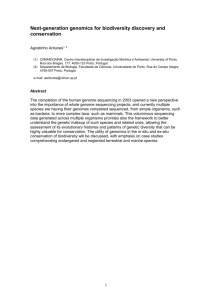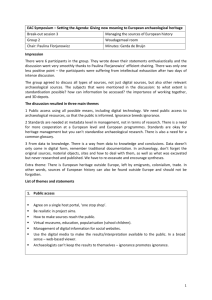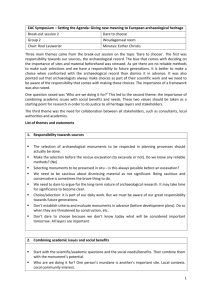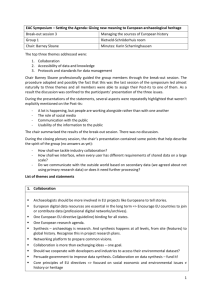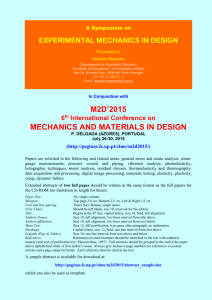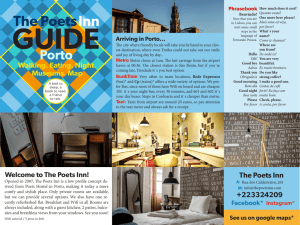F A X - Culturenet.cz
advertisement
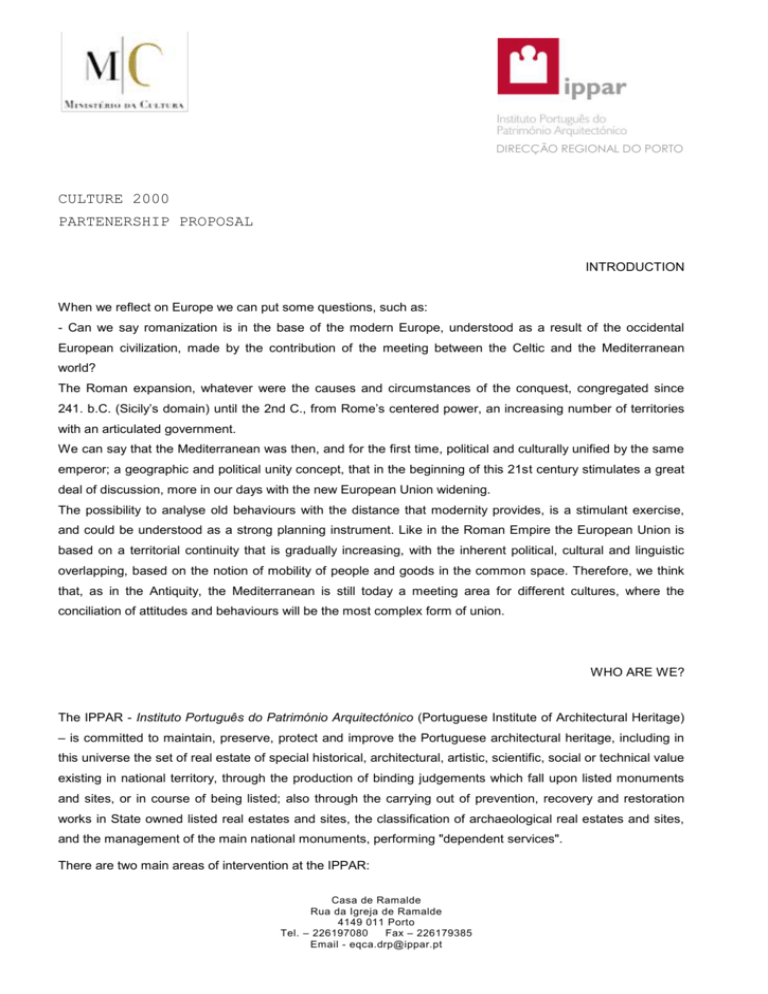
DIRECÇÃO REGIONAL DO PORTO CULTURE 2000 PARTENERSHIP PROPOSAL INTRODUCTION When we reflect on Europe we can put some questions, such as: - Can we say romanization is in the base of the modern Europe, understood as a result of the occidental European civilization, made by the contribution of the meeting between the Celtic and the Mediterranean world? The Roman expansion, whatever were the causes and circumstances of the conquest, congregated since 241. b.C. (Sicily’s domain) until the 2nd C., from Rome’s centered power, an increasing number of territories with an articulated government. We can say that the Mediterranean was then, and for the first time, political and culturally unified by the same emperor; a geographic and political unity concept, that in the beginning of this 21st century stimulates a great deal of discussion, more in our days with the new European Union widening. The possibility to analyse old behaviours with the distance that modernity provides, is a stimulant exercise, and could be understood as a strong planning instrument. Like in the Roman Empire the European Union is based on a territorial continuity that is gradually increasing, with the inherent political, cultural and linguistic overlapping, based on the notion of mobility of people and goods in the common space. Therefore, we think that, as in the Antiquity, the Mediterranean is still today a meeting area for different cultures, where the conciliation of attitudes and behaviours will be the most complex form of union. WHO ARE WE? The IPPAR - Instituto Português do Património Arquitectónico (Portuguese Institute of Architectural Heritage) – is committed to maintain, preserve, protect and improve the Portuguese architectural heritage, including in this universe the set of real estate of special historical, architectural, artistic, scientific, social or technical value existing in national territory, through the production of binding judgements which fall upon listed monuments and sites, or in course of being listed; also through the carrying out of prevention, recovery and restoration works in State owned listed real estates and sites, the classification of archaeological real estates and sites, and the management of the main national monuments, performing "dependent services". There are two main areas of intervention at the IPPAR: Casa de Ramalde Rua da Igreja de Ramalde 4149 011 Porto Tel. – 226197080 Fax – 226179385 Email - eqca.drp@ippar.pt DIRECÇÃO REGIONAL DO PORTO Heritage Recovery and Improvement Protection of the Built Heritage and its contexts Nowadays, both areas are duly articulated. The former area of intervention, Heritage Recovery and Improvement, comprehends a direct intervention upon cultural monuments and goods, through qualified actions involving, namely, the inventory, recovery, repair, maintenance, restoration and accomplishment of several projects whether in the built heritage and its own surroundings, or also in the mobile and integrated heritage (painting, religious sculpture, furniture, etc., and the so called "original" real estate heritage, such as carving, mural painting or ornamental tiles). In this context, the IPPAR is in charge of the management of the main national monuments (Palaces, Monasteries, Castles and Archaeological Stations). One of the "dependent services" of IPPAR is Tongobriga - Freixo Archaeological Zone, a special place to travel in time, for knowledge and investigation, as well as for professional education directed to the needs of the archaeological activity. We can found this Archaeological Station at Marco de Canaveses, a village in the north of Portugal, near Oporto. http://www.tongobriga.net/en/site/ Tongobriga, whose peak has been identified as the second half of the 2nd c., occupied an area of about 50 hectares, including the necropolis, so that, in comparison with other Roman towns, may be considered as being of medium size. The residential areas occupied about 5 to 7 hectares, indicating a population of 2000 to 2500 people. Excavation work has shown that at the 1st century and well into the 2nd, Tongobriga appeared as a socio-economic entity that concentrated not only residential characteristics but also a handicraft industry and systematic trading, which justified the building of a forum.In the 5th century, Tongobriga is reported as being part of a Suevi parish, after which it is lost in the mists of time. Today, it is a small village that grew around the parish church, which was built on the same site of an earlier Christian one. There are currently around 50 hectares that have been classified as a National Monument and designated as “Archaeological Site of Freixo”. The management of a site as this, with a vocation extended to the public enjoyment and to the continuous archaeological investigation, imposes the care to search for other realities, other examples that could be found in the current European territory and that seat on similar stratigraphies. The work proposal we would like to develop with other European states will be by sharing the management Casa de Ramalde Rua da Igreja de Ramalde 4149 011 Porto Tel. – 226197080 Fax – 226179385 Email - eqca.drp@ippar.pt DIRECÇÃO REGIONAL DO PORTO experience of Tongobriga - Freixo Archaeological Zone with other archaeological sites, and to promote technical and scientific seminars to expose the potentialities that cultural heritage has for a common development strategy. CONTACTS For more information please contact Mário Carneiro mailto:mjcarneiro@ippar.pt or Lino Tavares Dias - Director Direcção Regional do Porto do IPPAR Casa de Ramalde Rua da Igreja de Ramalde 4149-011 Porto Portugal Tel. +351 22 6197080, fax. +351 22 6179385 Casa de Ramalde Rua da Igreja de Ramalde 4149 011 Porto Tel. – 226197080 Fax – 226179385 Email - eqca.drp@ippar.pt
